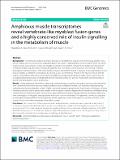Files in this item
Amphioxus muscle transcriptomes reveal vertebrate-like myoblast fusion genes and a highly conserved role of insulin signalling in the metabolism of muscle
Item metadata
| dc.contributor.author | Aase-Remedios, Madeleine Emma | |
| dc.contributor.author | Coll-Lladó, Clara | |
| dc.contributor.author | Ferrier, David Ellard Keith | |
| dc.date.accessioned | 2022-02-03T16:30:10Z | |
| dc.date.available | 2022-02-03T16:30:10Z | |
| dc.date.issued | 2022-02-01 | |
| dc.identifier | 277632394 | |
| dc.identifier | 84a2b43a-ae6d-4ff0-9d67-747aae54e18a | |
| dc.identifier | 85123974795 | |
| dc.identifier | 000749523800001 | |
| dc.identifier.citation | Aase-Remedios , M E , Coll-Lladó , C & Ferrier , D E K 2022 , ' Amphioxus muscle transcriptomes reveal vertebrate-like myoblast fusion genes and a highly conserved role of insulin signalling in the metabolism of muscle ' , BMC Genomics , vol. 23 , 93 . https://doi.org/10.1186/s12864-021-08222-9 | en |
| dc.identifier.issn | 1471-2164 | |
| dc.identifier.other | ORCID: /0000-0003-3247-6233/work/107717977 | |
| dc.identifier.uri | https://hdl.handle.net/10023/24804 | |
| dc.description | Madeleine E. Aase-Remedios and Clara Coll-Lladó were supported by funding from the University of St Andrews, School of Biology and additional support from St Leonards College (MEAR), the CORBEL grant European Research Infrastructure cluster project and European Assemble Plus (H2020-INFRAIA-1-2016-2017; grant no.730984). Transcriptome sequencing was done with an award under the BBSRC TGAC Capacity and Capability Challenge. | en |
| dc.description.abstract | Background: The formation and functioning of muscles are fundamental aspects of animal biology, and the evolution of ‘muscle genes’ is central to our understanding of this tissue. Feeding-fasting-refeeding experiments have been widely used to assess muscle cellular and metabolic responses to nutrition. Though these studies have focused on vertebrate models and only a few invertebrate systems, they have found similar processes are involved in muscle degradation and maintenance. Motivation for these studies stems from interest in diseases whose pathologies involve muscle atrophy, a symptom also triggered by fasting, as well as commercial interest in the muscle mass of animals kept for consumption. Experimentally modelling atrophy by manipulating nutritional state causes muscle mass to be depleted during starvation and replenished with refeeding so that the genetic mechanisms controlling muscle growth and degradation can be understood. Results: Using amphioxus, the earliest branching chordate lineage, we address the gap in previous work stemming from comparisons between distantly related vertebrate and invertebrate models. Our amphioxus feeding-fasting-refeeding muscle transcriptomes reveal a highly conserved myogenic program and that the pro-orthologues of many vertebrate myoblast fusion genes were present in the ancestral chordate, despite these invertebrate chordates having unfused mononucleate myocytes. We found that genes differentially expressed between fed and fasted amphioxus were orthologous to the genes that respond to nutritional state in vertebrates. This response is driven in a large part by the highly conserved IGF/Akt/FOXO pathway, where depleted nutrient levels result in activation of FOXO, a transcription factor with many autophagy-related gene targets. Conclusion: Reconstruction of these gene networks and pathways in amphioxus muscle provides a key point of comparison between the distantly related groups assessed thus far, significantly refining the reconstruction of the ancestral state for chordate myoblast fusion genes and identifying the extensive role of duplicated genes in the IGF/Akt/FOXO pathway across animals. Our study elucidates the evolutionary trajectory of muscle genes as they relate to the increased complexity of vertebrate muscles and muscle development. | |
| dc.format.extent | 21 | |
| dc.format.extent | 3670608 | |
| dc.language.iso | eng | |
| dc.relation.ispartof | BMC Genomics | en |
| dc.subject | Cephalochordate | en |
| dc.subject | Lancelet | en |
| dc.subject | Muscle development | en |
| dc.subject | Insulin Growth Factor | en |
| dc.subject | FOXO | en |
| dc.subject | Gene duplication | en |
| dc.subject | Genome duplication | en |
| dc.subject | QH426 Genetics | en |
| dc.subject | QP Physiology | en |
| dc.subject | DAS | en |
| dc.subject.lcc | QH426 | en |
| dc.subject.lcc | QP | en |
| dc.title | Amphioxus muscle transcriptomes reveal vertebrate-like myoblast fusion genes and a highly conserved role of insulin signalling in the metabolism of muscle | en |
| dc.type | Journal article | en |
| dc.contributor.institution | University of St Andrews. School of Biology | en |
| dc.contributor.institution | University of St Andrews. St Andrews Bioinformatics Unit | en |
| dc.contributor.institution | University of St Andrews. Centre for Biophotonics | en |
| dc.contributor.institution | University of St Andrews. Marine Alliance for Science & Technology Scotland | en |
| dc.contributor.institution | University of St Andrews. Scottish Oceans Institute | en |
| dc.identifier.doi | 10.1186/s12864-021-08222-9 | |
| dc.description.status | Peer reviewed | en |
This item appears in the following Collection(s)
Items in the St Andrews Research Repository are protected by copyright, with all rights reserved, unless otherwise indicated.

